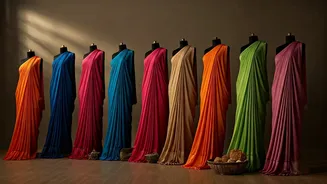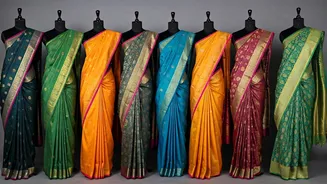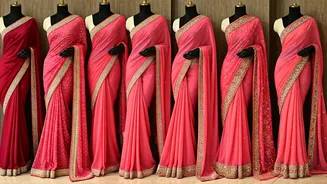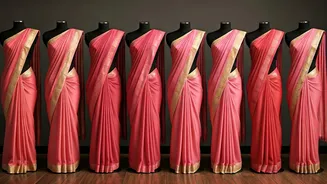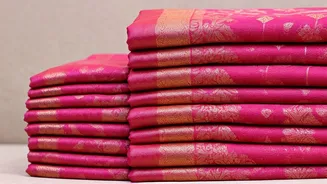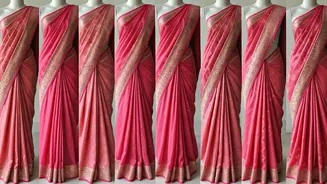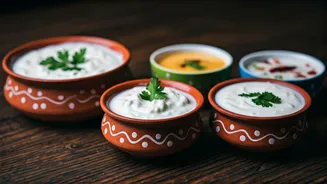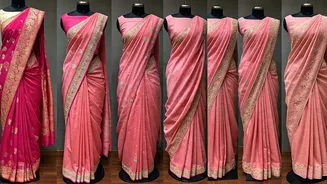Lucknawi Chikankari
The Lucknawi Chikankari saree epitomizes delicate embroidery, making it a timeless choice. Originating from Lucknow, this saree features intricate white-on-white
embroidery, primarily using cotton or muslin fabrics. The designs often showcase floral motifs and paisleys, known for their subtle elegance and lightweight feel, perfect for warm climates. Chikankari sarees are not only aesthetically pleasing but also a testament to the skilled craftsmanship of Lucknow's artisans, representing a blend of tradition and sophistication that suits all occasions.
Banarasi Silk's Grandeur
Banarasi silk sarees, crafted in Varanasi, are celebrated for their rich brocade work. These sarees are woven with real gold and silver threads (zari), adding a touch of opulence. Typically made from silk, these sarees feature elaborate designs like floral motifs, paisleys, and geometric patterns. The weight and grandeur of Banarasi silk make it ideal for weddings and festive occasions. The intricate weaving techniques and use of luxurious materials define these sarees, making them a significant part of Indian cultural heritage.
The Beauty of Kota Doria
Kota Doria sarees, hailing from Kota, Rajasthan, are known for their distinctive square check patterns. These sarees are woven from a blend of cotton and silk, offering a sheer and lightweight texture, perfect for the Indian climate. The square patterns are created through a unique weaving technique that incorporates fine threads, giving the fabric a delicate appearance. Kota Doria sarees are easy to drape and ideal for everyday wear, providing a balance of comfort and style. They represent simplicity and elegance, making them a versatile addition to any wardrobe.
Bandhani's Vibrant Hue
Bandhani sarees, originating from Gujarat and Rajasthan, are characterized by their tie-dye technique. These sarees involve tying small sections of the fabric and dyeing them to create intricate patterns. These patterns range from dots to complex geometric designs, using vibrant colors that symbolize joy and festivity. Bandhani sarees, typically made of cotton or silk, are perfect for adding a pop of color to any occasion. The vibrant colors and unique designs of Bandhani sarees reflect the lively culture of the regions they come from, making each piece unique.
Patola Silk: Double Ikat
Patola silk sarees, made in Gujarat, stand out due to their double ikat weaving technique, where both warp and weft threads are dyed before weaving, creating intricate designs on both sides. These sarees are known for their vibrant and complex patterns, often featuring geometric and floral motifs. Patola silk sarees are typically made from silk and are highly valued for their durability and beauty. The production process is complex, involving the skills of experienced artisans, resulting in sarees that are treasured as heirloom pieces due to their artistry.
Kanjeevaram Silk
Kanjeevaram silk sarees, traditionally from Tamil Nadu, are also popular in North India. While their origin is South Indian, their popularity has expanded. These sarees are made of pure mulberry silk and are known for their vibrant colors and rich textures. They often include broad borders featuring temple designs, floral motifs, or geometric patterns woven with gold zari. Kanjeevaram sarees are ideal for festive and wedding occasions, celebrated for their luxurious feel and cultural significance, making them a part of the traditional attire.
Gota Patti's Glamour
Gota Patti sarees are embellished with Gota Patti embroidery, a type of applique work originating from Rajasthan. Thin ribbons of gold or silver are applied to the fabric in various shapes and patterns, creating a shimmering effect. Gota Patti sarees can be made from various fabrics like georgette or chiffon. They are often worn for celebrations, especially weddings and festivals, adding an element of sparkle and elegance. This traditional craft transforms simple fabrics into festive wear, making them a popular choice.
Chanderi Silk: Lightness
Chanderi silk sarees, from Madhya Pradesh, are known for their sheer texture and lightweight feel. They blend silk and cotton, sometimes with zari work, producing a delicate fabric that drapes beautifully. The sarees are decorated with intricate patterns, including geometric designs, floral motifs, and traditional coin patterns. Chanderi sarees are ideal for warmer climates and semi-formal occasions, offering comfort and style. The weaving process and the use of fine threads contribute to their elegance, making them suitable for everyday elegance.
Maheshwari Silk Sarees
Maheshwari silk sarees, originating from Maheshwar, Madhya Pradesh, are characterized by their vibrant designs and contrasting borders. These sarees usually have a combination of silk and cotton, which makes them easy to wear in different seasons. The designs often include geometric patterns, stripes, and checks, with reversible borders that add to their versatility. Maheshwari sarees are known for their durability and simple elegance, making them perfect for both casual and formal wear. The blend of tradition and simplicity makes them a wardrobe essential.
Tussar Silk's Appeal
Tussar silk sarees are made from a unique silk produced by silkworms that feed on plants other than mulberry. These sarees offer a natural golden hue and a slightly textured feel. Tussar silk sarees, often adorned with traditional motifs and patterns, are celebrated for their understated elegance. They are often worn for special occasions due to their rich texture and natural shine, representing a blend of comfort and luxury. Tussar silk's natural color and texture make it a distinctive choice that suits those who value both tradition and sustainability.
